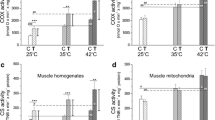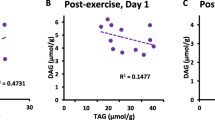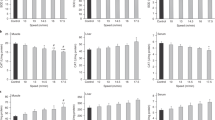Summary
The influence of physical activity on tissue metabolism is still largely unknown, in spite of the fact that several studies have been reported in this area. The purpose of this study was to determine more precisely whether a daily endurance type of exercise has any influence on the resting aerobic metabolism of the key tissues involved in exercise.
The oxygen consumption of tissue slices of heart, skeletal muscle and liver of trained and nontrained rats was determined using the Warburg technique. The tissue respiration was measured using a gas phase of 95% O2, 5% CO2 and with added substrates of either glucose or pyruvate. 22 rats were progressively trained for 5–8 weeks in a motorized running wheel apparatus, reaching a rate of 1 mile per hour for an hour each day at the end of the 4th week. They were then held at this running rate each day until sacrificed. 20 rats were used as controls; these remained in their cages with no exercise available.
The results show that an endurance type of training, as used here, has little effect on the resting aerobic metabolism of heart or skeletal muscle tissue, regardless of the substrate employed. The oxygen consumption of liver slices, however, was significantlylower in the chronic exercised rats. The trained rats had\(Q_{{\text{O}}_{\text{2}} }\) values of 9.9 and 12.6 μl per milligram dry weight per hour with glucose and pyruvate, respectively, whereas the nontrained liver slices had higher\(Q_{{\text{O}}_{\text{2}} }\) values of 12.3 and 13.9 with glucose and pyruvate substrates. Thus, training appears to shift the liver resting metabolism to a lower level. Also, training appears to cause an increase in density of trained tissues, as reflected in lower wet weight/dry weight ratios found in the trained tissues.
Similar content being viewed by others
References
Altland, P., Highman, B., Garbus, J.: Exercise training and altitude tolerance in rats: blood, tissue, enzyme and isoenzyme changes. Aerospace Med.35, 1034–1039 (1964).
Bruman, P., Goldman, H., Jenny, U. F.: Untersuchungen zum Studium des Trainiertsems. VI. Mittlg. Die Atmung der trainierten Muskulatur. Arbeitsphysiologie8, 453–454 (1935).
Clark, R., Jr., Powel, N., Criscuolo, D., Chinn, H., Ellis, J.: Tissue respiration studies during chronic altitude and cold exposure. Amer. J. Physiol.177, 207–210 (1954).
Depocas, F.: Biochemical changes in exposure and acclimation to cold environments. Brit. med. Bull.17, 25–31 (1961).
Duckworth, M.: Tissue changes accompanying acclimatization to low oxygen in the rat. J. Physiol. (Lond.)156, 603–610 (1961).
Frehn, J., Anthony, A.: Respiration of liver slices from normal and altitude acclimatized rats. Amer. J. Physiol.200, 527–529 (1961).
Glick, J., Bronk, J.: The effect of exercise on the rate of oxygen uptake by ratliver mitochondria. Biochim. biophys. Acta (Amst.)82, 165–167 (1964).
Holloszy, J.: Biochemical adaptations in muscle. Effects of exercise on mitochondrial oxygen uptake and respiratory enzyme activity in skeletal muscle. J. biol. Chem.242, 2278–2282 (1967).
Krebs, H., Eggleston, L. V.: The oxidation of pyruvate in pigeon breast muscle. Biochem. J.34, 442–459 (1940).
Munro, D., Anthony, A.: Respiration and oxidative phosphorylation in liver tissue from hibernating and active chipmunks. Proc. Penn. Acad. Sci.39, 114–120 (1965).
Paul, M., Sperling, E.: Cyclophorase system. XXIII. Correlation of cyclophorase activity and mitochondrial density in striated muscle. Proc. Soc. exp. Biol. (N.Y.)79, 352–354 (1952).
Pelosi, G., Agliati, G.: The heart muscle in functional overload and hypoxia: a biochemical and ultrastructural study. Lab. Invest.18, 86–93 (1968).
Poland, J., Blount, D.: Metabolic adaptations in myocardial tissue during repeated exercise. Proc. West Va. Acad. Sci.39, 287–293 (1967).
Prosser, C., Bart, L., Ping, R., Lauer, C.: Acclimatization of goldfish to low concentrations of oxygen. Physiol. Zool.30, 137–141 (1957).
Sorenyi, E., Tchepinova, O.: Cit. by A. Palladin. The biochemistry of muscle training. Science102, 576–578 (1945).
Stere, A., Munro, D., Anthony, A.: The effect of severe hypoxia and food restriction on cellular respiration rates in rats. Proc. Penn. Acad. Sci.39, 107–113 (1965).
Strickland, E., Ackerman, E., Anthony, A.: Respiration and phosphorylation in liver and heart mitochondria from altitude exposed rats. J. appl. Physiol.17, 535–538 (1962).
Tharp, G., Tipton, C.: Influence of training on tissue respiration. Arbeitsphysiologie22, 236–239 (1966).
Tipton, C.: Training and bradycardia in rats. Amer. J. Physiol.209, 1089–1094 (1965).
Ullrick, W., Whitehorn, W., Brennan, B., Krone, J.: Tissue respiration of rats acclimatized to low barometric pressure. J. appl. Physiol.9, 49–52 (1956).
Umbreit, W. W., Burris, R. H., Stauffer, J. F.: Manometric techniques. Minneapolis: Burgess 1964.
Val'nov, N., Dibner, R., Rogozkin, V., Afar, I.: Functional and biochemical changes in cardiac muscle during training. Fiziol. Zh. (Mosk.) (Sechenov physiol. J. U.S.S.R.)52, 159–165 (1966).
Verzhbinskaya, N.: Tissue mechanisms of adaptation of animals to lowered oxygen content of the environment. Fed. Proc. Trans. Suppl.22, 582–588 (1962).
Whitehorn, W., Ullrick, W., Krone, J., Brennan, B.: Influence of low oxygen tensions on respiration of tissues of acclimatized rats (abstract). Fed. Proc.12, 154 (1953).
Yampolskaya, L.: Biochemical changes in the muscles of trained and untrained animals under the effect of small loads. Fiziol. Zh. (Mosk.) (Sechenov physiol. J. U.S.S.R.)38, 91–99 (1962).
Author information
Authors and Affiliations
Additional information
Studies from the Department of Zoology, University of Nebraska Number 435. Supported in part by the University of Nebraska Research Council Summer Fellowship.
Rights and permissions
About this article
Cite this article
Tharp, G.D. Tissue respiration changes in chronic exercise. Int. Z. Angew. Physiol. Einschl. Arbeitsphysiol. 29, 195–202 (1971). https://doi.org/10.1007/BF01100531
Received:
Issue Date:
DOI: https://doi.org/10.1007/BF01100531




